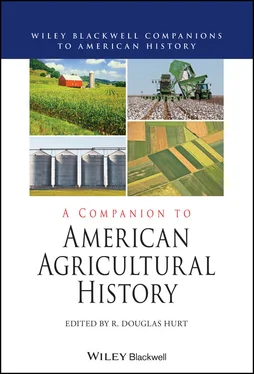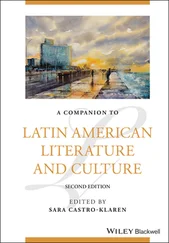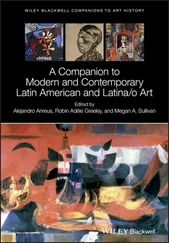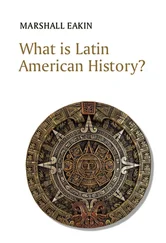Chapter 2 NORTH AMERICAN COLONIAL AGRICULTURE
Taylor Spence
Any overview of colonial North American agriculture must take into account the sociopolitical context created by European colonialism and imperialism. These invasive and violent forms of extraction, including agricultural and human resources, should be considered “total social facts” of post-invasion life on the continent (Gosden 2004). The quite similar biomes of Western Europe and many parts of North America meant that agricultural practices transferred to the continent with colonization. However, the transfer of intercommoning, rotational field practices, manuring, and livestock to the Americas transformed European agricultural practices into the means of colonization. Thus, when one considers colonial North American agriculture, one must consider how European agricultural tradition became colonial American praxis.
Furthermore, colonial agriculture cannot be disentangled from European encounters with indigenous agricultural methods, both Native American and displaced African indigenous practices. Before the advent of Europeans, Indigenous North Americans developed unique cultigens such as corn, rice, and squash and the practices that maximized the yields of these crops. They husbanded game such as white-tail deer, beaver, and pigeons. These American crops were the product of intellect and experimentation, and contributed valuable nutrition to both Indigenous People and colonials. Any accounting of colonial agriculture must reckon with what colonials took from the people who were their neighbors.
Similarly, indigenous African knowledge and cultigens transferred with chattel slaves. The idea that Africans supplied the labor while white planters supplied the technical knowledge has long been disproven. Africans brought with them long grain rice cultivars and the knowledge to grow them, which included being able to identify locations where they could grow. Marijuana ( Cannabis indica ) and the knowledge to cultivate and use it transferred with slaves to the Caribbean and thence to North America (Duvall 2019). The two most important slave-labor agricultural commodities, sugar and cotton, were cultigens developed by indigenous non-Europeans from the Americas and Southeast Asia. European imperialism constituted more than just the taking of others’ homes, the extraction of natural resources, and the expropriation of human lives. It included forcibly taking knowledge from subaltern peoples (Norton 2017).
It is not possible at this point to write a wide-ranging historiographical entry cataloging all the monographs about these aspects of colonial North American agriculture, because that work is still in its infancy. Histories written with an awareness of the enmeshment of colonizer and colonized at both the level of bodies and intellect constitute the avant-garde of agricultural history, with scholars from outside the United States leading the way (Norton 2017; Camfield 2019). Therefore, this chapter traces the outlines of several important areas of future scholarly inquiry about colonial North American agriculture, highlighting the work of scholars who are working with an awareness of colonization and empire. Works that separate agricultural practices from these sociopolitical realities are not discussed, because they lack historical validity in light of current efforts towards decolonization and reparations. By shifting the conversation away from a colonial agricultural history denuded of the politics of empire and colonization, this chapter seeks to spur further research into how European agricultural methods transferred to North America, and were transformed into tools of violence and the means of conquest. The narrative part of the chapter offers a schematic sketch of how colonial land-use practices became the means of colonization, while the subsequent bibliographic chapter focuses on the forced knowledge transfers of indigenous and African agricultural technologies in the colonial era.
The concept of knowledge transfer is fundamental to understanding the violent nature of colonial agriculture in North America. Transfer of pathogens, cultivars, and people is well understood. Transfer of European customs and ways of thinking in terms of religion, politics, and culture has been well explored. Yet, the transfer of agricultural methods, traditions, and technology has been assumed to be a passive infiltration and thus largely overlooked. The practice of agriculture combines space, the environment, and culture. In a society based in the extraction of life from the biologic world, this agric-culture may have comprised the most widely practiced set of shared beliefs in the colonies. Understanding the transformation of these transplanted ways of using space and natural resources is a key step in comprehending the violence of colonial agriculture (Mt. Pleasant 2015).
A deeper understanding of agricultural knowledge transfers better explains the successes of European colonization. The emphasis of much of the work on colonial North America emphasizes the hardship and difficulty colonists experienced in their acts of settlement and producing food. In New France, New England, and New Spain, settlers struggled through extreme winters and blazing hot summers, as Karen Kupperman and others have noted, due to North America’s continental rather than oceanic climate. Extreme fluctuations in temperature occurred during the Little Ice Age (1300–1850), with the most extreme being between 1550–1700 (Kupperman 1982; Rockman 2010). Jamestown, settled in 1607, experienced an extreme drought at the time of settlement (Rockman 2010). The more extreme climate of North America played havoc with European colonists’ assumptions about what they could successfully cultivate. Nevertheless, climatic conditions were not so extremely different that many of the long-used methods of European agriculture could not be adapted. Western Europe and the eastern US are both part of the same temperate forest biome. This meant that many agricultural methods, including crop rotation, manuring, and intercommoning transferred to colonial locations, making the transition from metropole to periphery relatively easy.
Ultimately, colonies survived and prospered because of an array of factors, not least of which was European willingness to take the lives, lands, and ideas of Indigenous and African Peoples and use them for their own ends. The processes by which these takings took place were both active, as with enslavement, land, resource, and knowledge theft, and passive, as when colonizers relied on their agricultural techniques and practices to facilitate their taking and domination. The passive-aggressive character of colonial agriculture was the direct result of the change in context from imperial metropole to colonial periphery.
The notion of taking and sharing natural resources in local communities might be as close to a universal of the human experience as birth and death. All societies have utilized commons, where extracting resources directly from the earth (whether from agriculture or otherwise) was necessary for survival. This was because certain life-sustaining resources could neither be controlled nor, morally speaking, hoarded. Nobel laureate economist Elinor Ostrom labeled resources that states cannot fully control but must negotiate to share “common pool resources” (CPRs; Ostrom 1990). The commons by their nature carry a moral and ethical valence because they are more or less basic to the survival of the community of humans (L. Taylor 1987). Examples today would include air, water, fisheries, and climate.
In precapitalist, preindustrial European societies, people needed many resources, field and forest, game and other forage, in order to survive. These resources were ones that the wealthy and powerful could (and in many cases did) easily monopolize. Over time, and with much struggle, people developed agricultural practices, legal statutes, and a moral and ethical code for regulating resource use and guaranteeing a subsistence. This was the basis of the old “common law.”
Читать дальше











